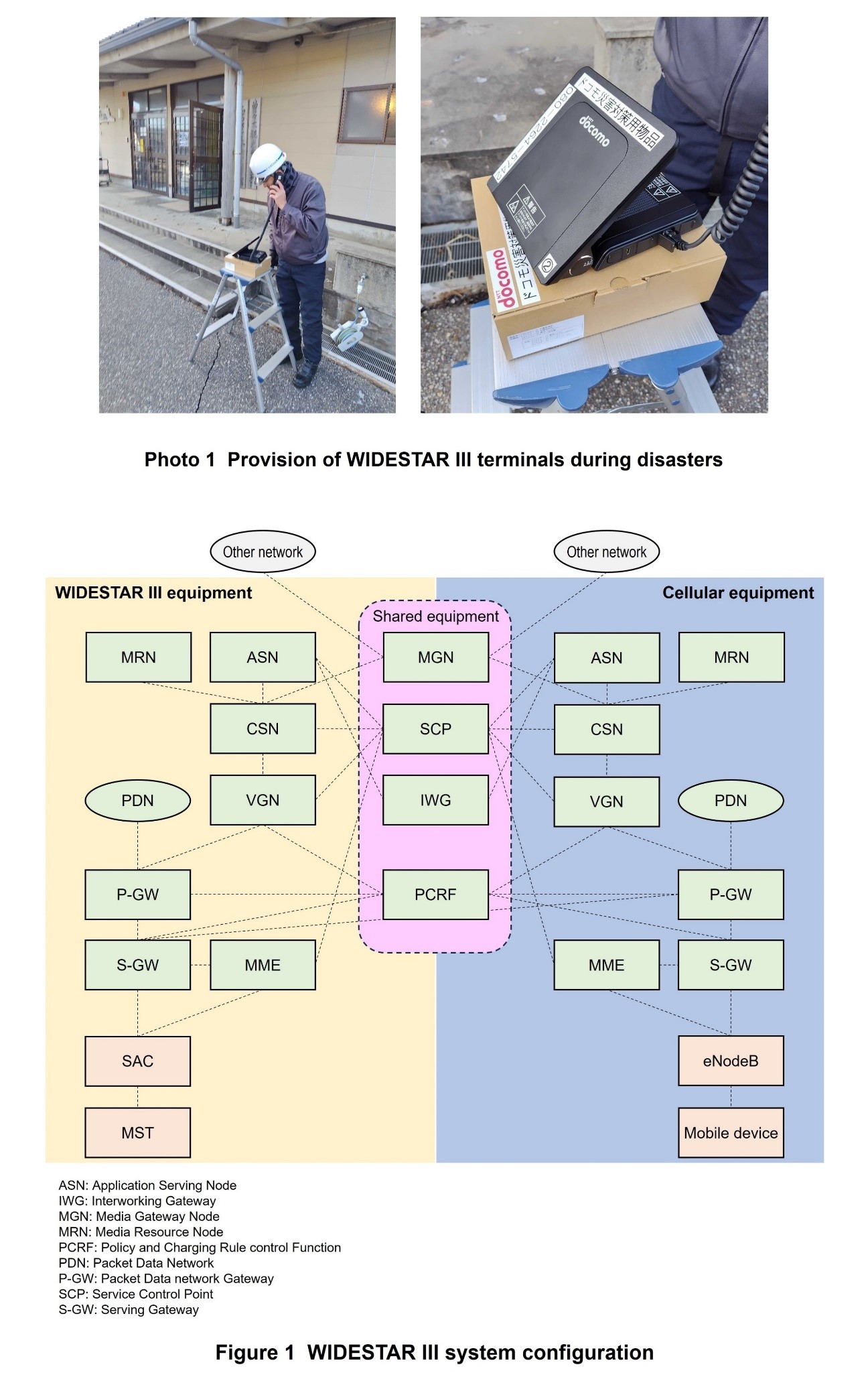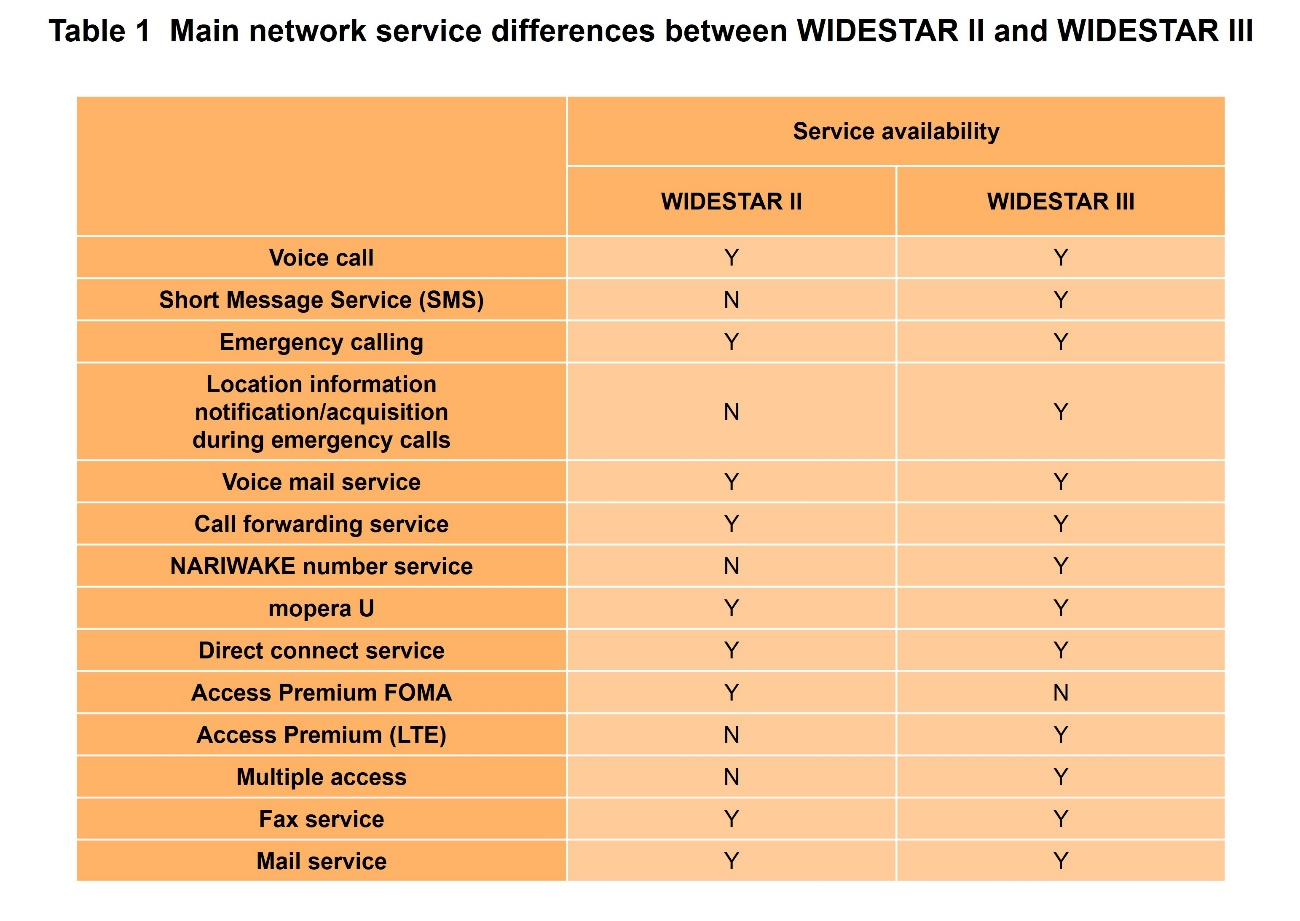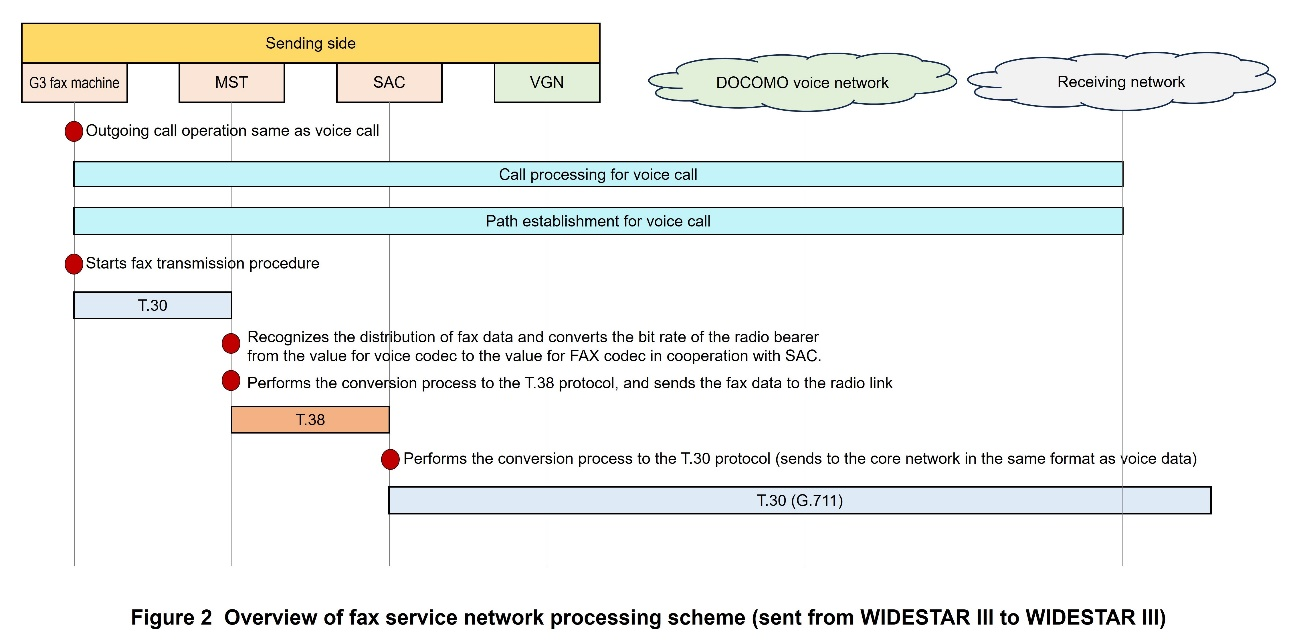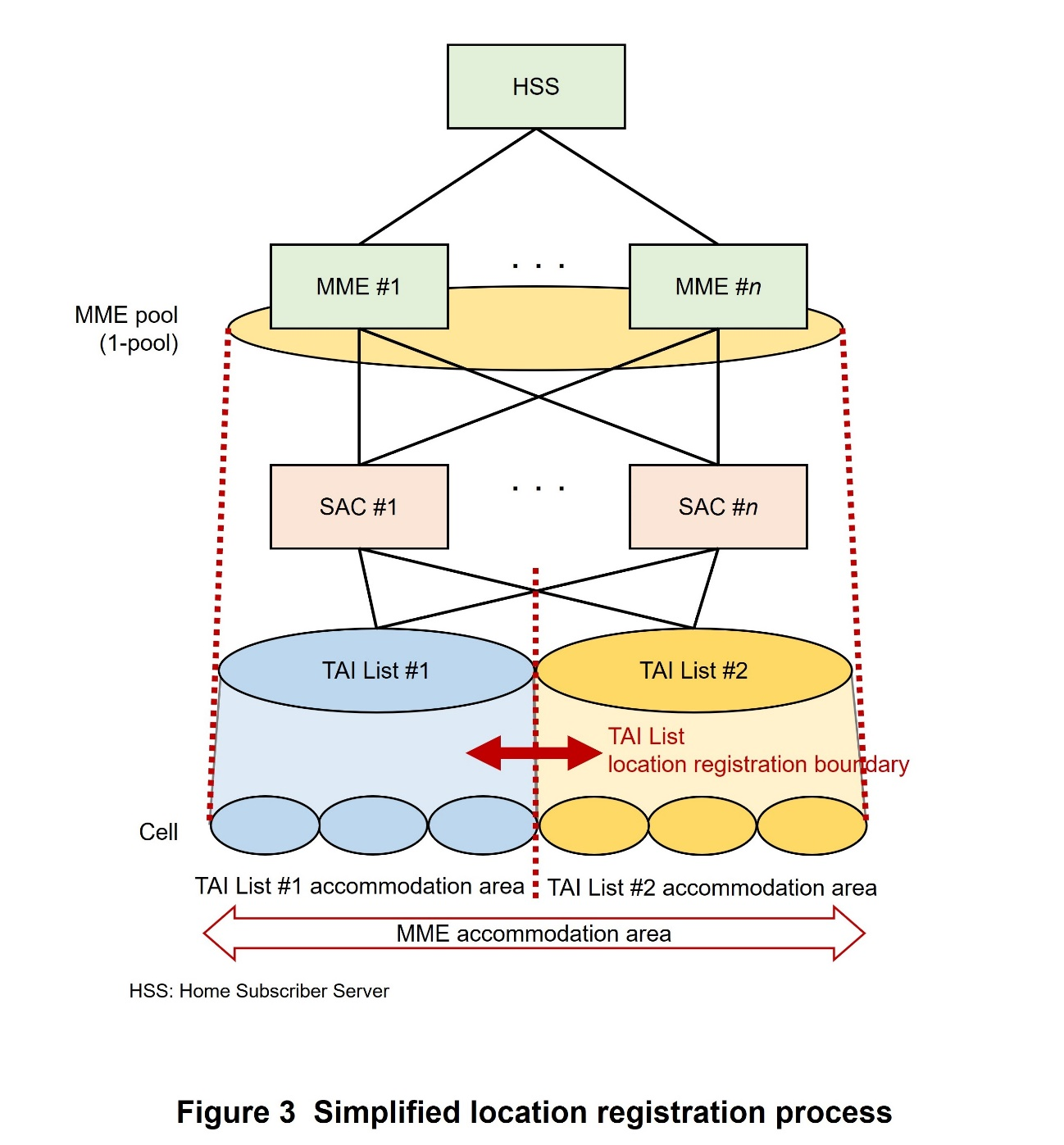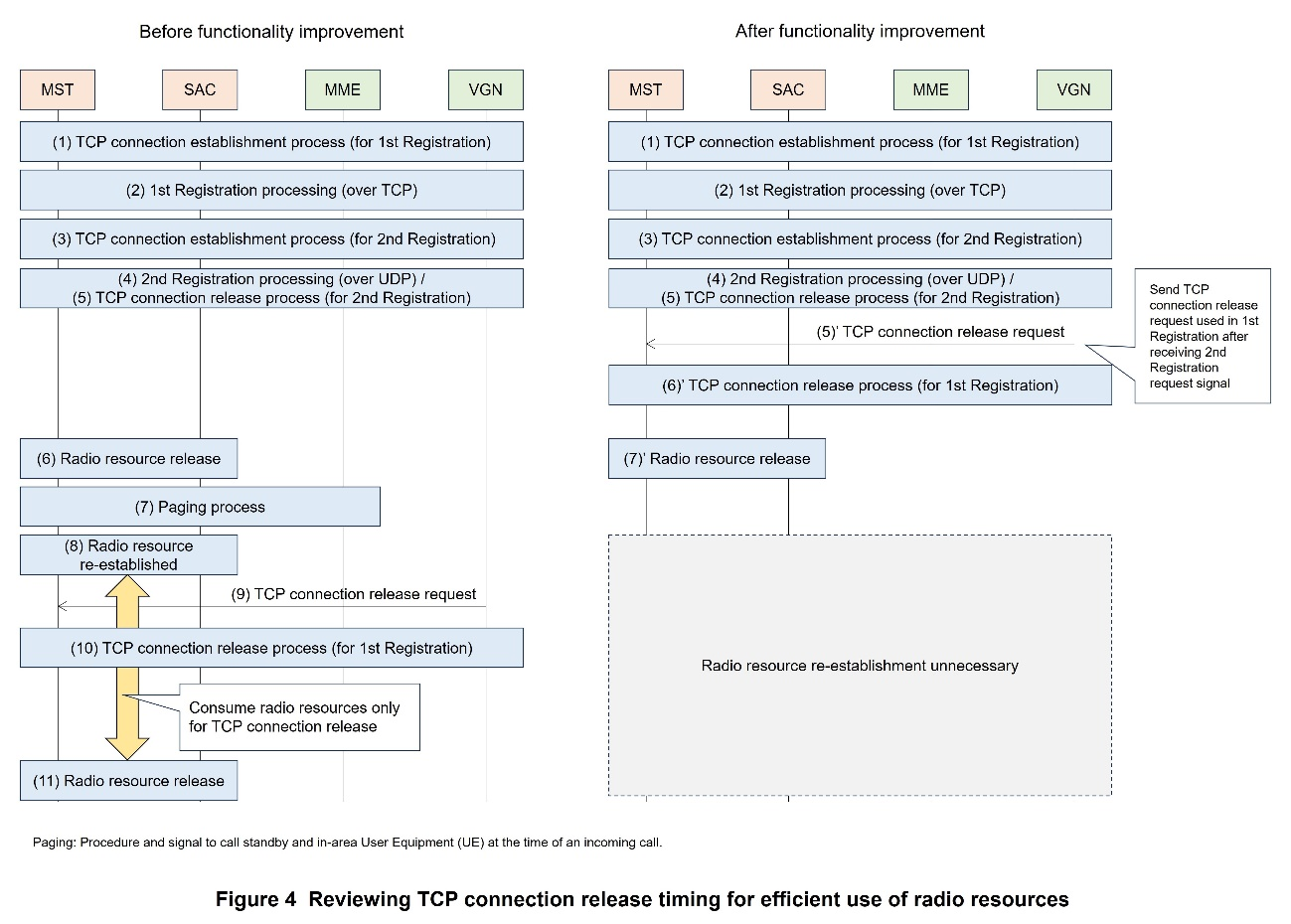Special Articles on Mobile Satellite Communications Systems (2)
Overview of WIDESTAR III Core Network System Development
LTE over GSO Satellite Core Network System Radio Resource Efficiency
Yosuke Kubo and Yuya Miyazaki
Core Network Design Department
Yoichi Kamiya
DOCOMO Technology, Inc., Core System Development Department
Yuichi Kaneko
DOCOMO Technology, Inc., Packet System Development Department
Abstract
WIDESTAR III, a mobile satellite communications service based on the LTE system, was launched in October 2023. The core network system for this service follows the architecture and functions of the LTE service system. This enables the efficient development of functions with existing assets to provide services equivalent to LTE at low usage fees, thereby improving user convenience. This article focuses on the system design policy that emphasizes development efficiency and the functional improvements compared to WIDESTAR II and describes an overview of the core network system technologies to achieve these goals.
01. Introduction
-
NTT DOCOMO has been providing mobile satellite communications services ...
Open

NTT DOCOMO has been providing mobile satellite communications services under the name of “WIDESTAR.” This communications satellite system plays a role as communications infrastructure*1 for maritime areas and remote islands that are difficult to cover with mobile communications services that use terrestrial base stations. WIDESTAR is a critical communications service that must be available not only in normal times, but also during disasters. Thus, this facility is designed to enable service provision even when land-based infrastructure is disrupted by a disaster.
NTT DOCOMO started providing the WIDESTAR service in March 1996. At the time, only voice communications were available. Packet communications services were then launched in March 2000, and in April 2010, “WIDESTAR II,” a successor service with faster communication speeds, was launched.
As a more user-convenient mobile satellite communications service, NTT DOCOMO launched WIDESTAR III, the successor to WIDESTAR II, in October 2023.
This article describes the overall picture of the core network*2 system of WIDESTAR III and its facility design concept, the function improvements compared to WIDESTAR II, and the characteristic technical elements that realize this mobile satellite communications service.
- Communications infrastructure: Refers to communications infrastructure facilities.
- Core network: A network consisting of packet switching equipment, subscription information management equipment, etc. A mobile terminal communicates with the core network via a radio access network (see *38).
-
The core network system of WIDESTAR III enables efficient service provision ...
Open

The core network system of WIDESTAR III enables efficient service provision by maximizing the use of existing assets, while ensuring critical communications during disasters through physical separation from the cellular system.
2.1 Efficient Service Delivery through Software Development Utilizing Existing Assets
The WIDESTAR III core network system utilizes the LTE*3 service infrastructure, which includes an IP Multimedia Subsystem (IMS)*4 that provides voice services such as Voice over LTE (VoLTE)*5 and an Evolved Packet Core (EPC)*6 that provides LTE data communications services. Its software is developed by maximizing use of existing assets and only developing new functions specific to mobile satellite communications services to efficiently provide new services.
In addition, under the policy of utilizing LTE service infrastructure, work on facility construction and maintenance/operation processes are integrated with LTE service infrastructure to enable efficient service provision and maintenance.
2.2 Ensuring Stable Communications during Disasters by Building a System Independent of Cellular Facilities
The core network system of WIDESTAR III is basically built as a dedicated facility, independent of cellular facilities. Therefore, even during a large-scale disaster, services can be provided stably without being affected by congestion*7 on the cellular side.
In the WIDESTAR III dedicated core network system, multiple systems that can handle 100% of the traffic on a single system are installed. These are distributed to stations with sufficient separation to reduce the risk of simultaneous damage, enabling more stable service provision during disasters. Photo 1 shows how NTT DOCOMO is supporting evacuation centers by providing WIDESTAR III terminals during the Noto Peninsula earthquake disaster that occurred in January 2024.
The overall configuration of the WIDESTAR III core network system is shown in Figure 1.
- LTE: A mobile telephony standard.
- IMS: A communications system standardized by the 3rd Generation Partnership Project (3GPP) that integrates communications services such as fixed telephone networks and mobile communications networks using IP technology and SIP (see *21), a protocol used in Internet telephony, and enables multimedia services.
- VoLTE: Technology that enables voice calls over LTE packet communications networks.
- EPC: A core network consisting of MME (see *27), S-GW, P-GW, and PCRF and providing functions such as authentication, mobility control, bearer (see *14) management, and QoS control.
- Congestion: A state where communication requests are concentrated inside a short time period and exceed the processing capabilities of the network, thereby obstructing communications.
-
The WIDESTAR III core network system is based on the LTE ...
Open

The WIDESTAR III core network system is based on the LTE service provision system. Some of the cellular services that were not provided with WIDESTAR II are available with WIDESTAR III. For example, with the fax service, user convenience has been improved by enabling sending and receiving of fax data in real time using G3 fax*8 and by providing the NARIWAKE Number Service*9.
3.1 Improved Serviceability Using LTE Service Infrastructure
The main network service differences between WIDESTAR II and WIDESTAR III are shown in Table 1. A distinctive difference in network service provision is the ability to simultaneously use Short Message Service (SMS)/voice call and data communications (multiple access*10) similar to the convenience of using a regular feature phone or smartphone, despite being a mobile satellite communications service. Although technically difficult to achieve with WIDESTAR II, WIDESTAR III also supports location information notification/acquisition functions during emergency calls so that emergency agencies can quickly and accurately determine the caller's location.
In addition, the telephone numbers of customers using WIDESTAR II can be used with WIDESTAR III (same-number transition) for convenience in transitioning between mobile satellite communications services.
3.2 Improved Fax Service Convenience Utilizing LTE System Infrastructure
1) Real-time Fax Data Transmission and Reception
WIDESTAR III uses G3 fax for its fax service.
The WIDESTAR II provided fax service functions using the Internet fax method*11. Data was sent and received via a fax server on the Internet, so there were no fax communications in real-time.
In contrast, WIDESTAR III can send and receive fax data as voice data by establishing a voice communication path between a G3 fax machine, a Satellite Access Controller (SAC)*12, and the core network, and by performing protocol conversion in the radio link to enable real-time transmission and reception of fax data. This has improved the convenience of fax services in mobile satellite communications services, which are expected to be used for maritime applications.
Conversion from voice data to fax data and vice versa is performed between a Mobile Satellite Terminal (MST)*13 and the SAC [1], so that the core network is not aware of the service type and operates in the same way as a voice connection in VoLTE. These innovations made it possible to provide a real-time fax service efficiently.
Figure 2 shows an overview of the network processing scheme for fax service in WIDESTAR III (sent from WIDESTAR III to WIDESTAR III).
Upon receiving an outgoing call operation from a fax machine, each system in the core network performs control similar to voice call processing in VoLTE.
After establishing the path for the voice call, the fax machine initiates the fax transmission procedure and sends the fax data using the T.30 protocol. Upon reception, the MST recognizes the fax data reception, changes the bit rate of the radio bearer*14 in cooperation with the SAC to the value for fax, performs the conversion process from the T.30 protocol*15 to the T.38 protocol*16, and sends the fax data to the SAC. The SAC receives it, converts the T.38 protocol to the T.30 protocol, and sends it to the core network. The receiving core network treats the fax data in the same way as voice data (equivalent to G.711*17) and sends it to the receiving end.
2) Simultaneous Use of Analog Telephone and Fax Machine through the NARIWAKE Number Service
The use of a dedicated fax ring tone number*18 enables the MST to separate ringing for incoming voice calls and incoming fax calls (NARIWAKE Number Service). This feature enables users to use both voice call and fax services while analog phones and fax machines are permanently connected to the MST, improving user convenience.
The implementation method of this functionality follows the Multi Number*19 function provided for cellular phones. Efficient development of this functionality is done utilizing existing assets. However, unlike the Multi Number, fax ring tone numbers are for incoming calls only. Therefore, some functions are suppressed in the core network so that they can be used only for specific purposes such as disabling voice call dialing.
- G3 fax: A fax standard, a method of transmitting digitized image data over a telephone line.
- NARIWAKE Number Service: A service that allows incoming voice/SMS calls and incoming fax calls to ring separately at different LINE terminals when receiving calls in MST (see *13).
- Multiple access: Performing different bearer accesses with a single terminal.
- Internet fax method: A method of transmitting digitized image data via an internet connection.
- SAC: A radio access device for satellite communications. Equivalent to an eNodeB in a cellular network.
- MST: A mobile terminal for satellite communications.
- Bearer: A logical communication path for data transmission between a mobile terminal and an endpoint.
- T.30 protocol: A fax communication protocol used on the fixed-line telephone network standardized by International Telecommunication Union-Telecommunication Standardization Sector (ITU-T).
- T.38 protocol: A fax communication protocol used on IP networks standardized by ITU-T.
- G.711: The first speech coding scheme standardized by ITU-T.
- Fax ring tone number: A phone number dedicated for fax communication, different from voice/SMS, to realize the NARIWAKE Number Service.
- Multi Number: An NTT DOCOMO service/function that allows one subscriber to use multiple phone numbers by adding additional numbers to the basic subscription number.
-
The WIDESTAR III core network system utilizes LTE service infrastructure ...
Open

The WIDESTAR III core network system utilizes LTE service infrastructure as much as possible. However, since mobile satellite communications have more limited radio resources*20 compared to cellular communications, the radio resources are used efficiently through the use of signal compression and unnecessary signal reduction techniques.
In addition, the various timer values used in the cellular system are tuned for WIDESTAR III based on the propagation delay in the radio link associated with satellite communications, enabling use of LTE service infrastructure.
4.1 Efficient Use of Radio Resources Using SigComp
The Session Initiation Protocol (SIP)*21 used for call control in voice communications is a text-based application protocol in which a single signal can be several thousand bytes, leading to inefficient use of radio resources. Efficient use of limited radio resources is essential for satellite communications services. The WIDESTAR III service makes this possible by compressing SIP signals using Signaling Compression (SigComp)*22, a signal compression technology.
SigComp is used between an MST and a VoLTE Gateway Node (VGN)*23. Upon receiving a SigComp compression instruction from an MST, a VGN compresses subsequent SIP signals with SigComp and sends/receives them to/from the MST. When the VGN receives a SIP signal compressed by SigComp from the MST, it uncompresses and forwards it to the Call Session Control Node (CSN)*24.
4.2 Simplified Location Registration Process for Efficient Use of Radio Resources
The Attach*25 (location registration) process is essential to maintain the connection and continue service usage when a mobile device moves to a new location. WIDESTAR III uses a network structure to reduce the number of location registration opportunities and improve the efficiency of the usage of limited radio resources. There are two typical triggers for location registration when moving from a cellular area to another: when moving from a Tracking Area Identity (TAI) List*26 accommodation area and when moving from a Mobility Management Entity (MME)*27 accommodation area, which both require their own location registration processing. In WIDESTAR III, a full-mesh connection*28 using S1-Flex*29 technology is applied between the MME and the SAC. The MME manages all TAI List accommodation areas in a 1-pool configuration, thereby reducing the number of opportunities for moving from an MME accommodation area and streamlining the location registration process. Figure 3 shows an image of simplified location registration process in WIDESTAR III.
4.3 Reviewing TCP Connection Release Timing for Efficient Use of Radio Resources
The difference in call processing schemes between WIDESTAR III and cellular is shown in Figure 4.
The authentication function using Security Architecture for Internet Protocol (IPsec)*30 is used between the MST and the core network. In SIP Registration*31, the core network performs two types of Registration. First, the core network performs Registration (hereafter referred to as “1st Registration”) to notify the MST of Authentication and Key Agreement (AKA)*32 authentication code. After that, the core network performs another Registration (hereinafter referred to as “2nd Registration”) to authenticate and register the location using the AKA calculation results received from the MST (Fig. 4 (1) to (4)).
When using Transmission Control Protocol (TCP)*33 as the transport protocol*34 for Registration, the TCP connection*35 used in the Registration (1st Registration) by the VGN is disconnected after the release of radio resources (Fig. 4 (6)), the Radio Resource Control (RRC) connection*36 between the MST and the SAC must be re-established (Fig. 4 (8)) to send and receive release request signals, which leads to undesirable radio resource consumption each time.
To address this, in WIDESTAR III, when the VGN receives the 2nd Registration request from the MST (Fig. 4 (4)), it sends a release request signal of the TCP connection used in the 1st Registration to the MST (Fig. 4 (5)'). This eliminates the need to re-establish the RRC connection between the MST and the SAC, enabling efficient use of radio resources. In the 2nd Registration, a different TCP connection is established from the 1st Registration, but since the communication is done using User Datagram Protocol (UDP)*37 due to MST operation, the TCP connection is released before the RRC connection is released, and radio resources are not unnecessarily consumed.
4.4 Timer Value Design that Considers Propagation Delay in the Radio Link
WIDESTAR III is a mobile satellite communications service using geostationary satellites located approximately 36,000 km above the equator, which causes higher propagation delay in the radio link compared to the LTE service provided for cellular. Therefore, if the timer values of various protocols in operation for cellular are applied as they are, there is a risk of call disconnections and signal retransmissions due to unexpected timeouts, which may degrade service quality and consume unnecessary resources.
In WIDESTAR III, the timer value is extended for mobile satellite communications to avoid timeouts due to propagation delay. This prevents unwanted service interruptions during customer use and improves service convenience. Furthermore, making it possible to independently set various timer values applied to existing cellular services means the existing core network system can accommodate access networks with different characteristics such as mobile satellite communications and prevent increases in communications charges by reducing network cost.
- Radio resources: Unit of time or frequency range allocated to each user for communication purposes.
- SIP: A call control protocol defined by the Internet Engineering Task Force (IETF) and used for IP telephony with VoIP, etc.
- SigComp: Control signal compression technology for compressing signals in application protocols such as SIP and Real Time Streaming Protocol (RTSP).
- VGN: A device that controls voice calls in VoLTE and operates equivalent to Proxy Call Session Control Function (P-CSCF) and Access Gateway (IMS-AGW) specified in the 3GPP standard.
- CSN: A node that performs session control in a voice network; an NTT DOCOMO device corresponding to Interrogating/Serving CSCF (I/S-CSCF) specified in the 3GPP standard.
- Attach: Processing to register a mobile terminal on a network when the terminal is turned on, etc.
- TAI List: Used to efficiently perform mobile terminal in-area movement processing. TAI consists of Public Land Mobile Network (PLMN), which identifies the network, and Tracking Area Code (TAC), which identifies the area of presence.
- MME: A logical node that houses the SAC and provides mobility control, etc.
- Full-mesh connection: A topology of a communications network in which all devices (nodes) on a network are connected to each other.
- S1-Flex: A feature that allows a radio base station to connect to multiple MME/S-GWs in an LTE network.
- IPsec: A protocol for highly secure communications by encrypting and authenticating IP packets themselves.
- SIP Registration: In IMS, registration of mobile UE current location data in HSS with SIP.
- AKA: A generic term for an authentication process that uses authentication and key generation; the Universal Subscriber Identity Module (USIM) generates a private key and an integrity check key based on parameters issued from the network, and checks the validity of those parameters.
- TCP: A communication protocol that corresponds to the transport layer of the OSI reference hierarchy model and enables stable communications with high reliability.
- Transport protocol: A protocol used on the transport layer. Main transport protocols on the Internet are connection-oriented TCP and connectionless UDP (see *37).
- TCP connection: A communication path established by TCP protocol.
- RRC connection: A communication path established by the RRC protocol (protocol to control radio resources).
- UDP: A communication protocol that corresponds to the transport layer of the OSI reference hierarchy model and enables low-delay communications due to its small header size and low overhead without establishing connections.
-
This article has described the design concept of the WIDESTAR III ...
Open

This article has described the design concept of the WIDESTAR III core network system and the innovations in mobile satellite communications service infrastructure. Since further diversification of the radio link is expected in the future, it will be important to improve the efficiency of service provision and system operation by, for example, efficiently accommodating multiple radio access networks*38 in the same core network system. NTT DOCOMO will utilize the know-how accumulated through the development of the WIDESTAR III services to develop an efficient and high-quality core network system to continue providing stable services to customers.
- Radio access network: A network consisting of radio base stations, radio line controllers, etc., located between the core network and mobile terminals.
-
REFERENCES
Open

- [1] H. Tahara et al.: “WIDESTAR III Satellite Base Station Equipment,” NTT DOCOMO Technical Journal, Vol. 26, No. 3, Jan. 2025.

